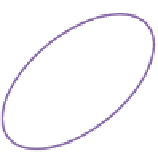Geography Reference
In-Depth Information
Distina µ
Class-3
Class-1
Class-2
Probability Contours
Overlap region
Spectral band A
data file values
Fig. 5.37
Maximum
likelihood
classifier
(MLC)
concept
(Source
modified
from
ERDAS
IMAGINE
, 1999)
curves. The likelihood degree function supposes that the representative sample
values for each presented class are normally distributed (Bastin
1997
). The so
called Gaussian threshold can border the class space in feature space, which is the
radius (in standard deviation units) of a hyper-ellipsoid around the mean of the
class in feature space. Here, observations which do not locate inside the hyper-
ellipsoid of any class are allocated to a null class (Strahler
1980
). The necessary
number of training samples needed to calculate the statistics of a class for a
Gaussian (quadratic) classifier is in addition linked to the square of features
number (Fukunaga
1990
). This presents increase in the Hughes effect: for a limited
number of training samples, the classification accuracy increases in the beginning
with the number of features (or difficulty in measurement), but then it attains a
maximum and begins to decrease when more features are added. It is generally
agreed that the class spectral separability is constantly higher for data with a
superior dimensionality, but this superior or higher dimensionality impacts and
decreases the accuracy of the statistics estimation when the dimensionality
becomes too high, and in some cases, this has the result of producing a lower
classification accuracy despite the presented and improved theoretical class sep-
arability (Landgrebe
2003
). Enough training samples for each spectral class of
interest must be presented to offer logical approximations of the elements of the
mean vector and the covariance matrix to be determined. For an (N) dimensional
multi-spectral space, at least (N ? 1) samples are needed, to avoid the covariance
matrix being singular.




































Search WWH ::

Custom Search